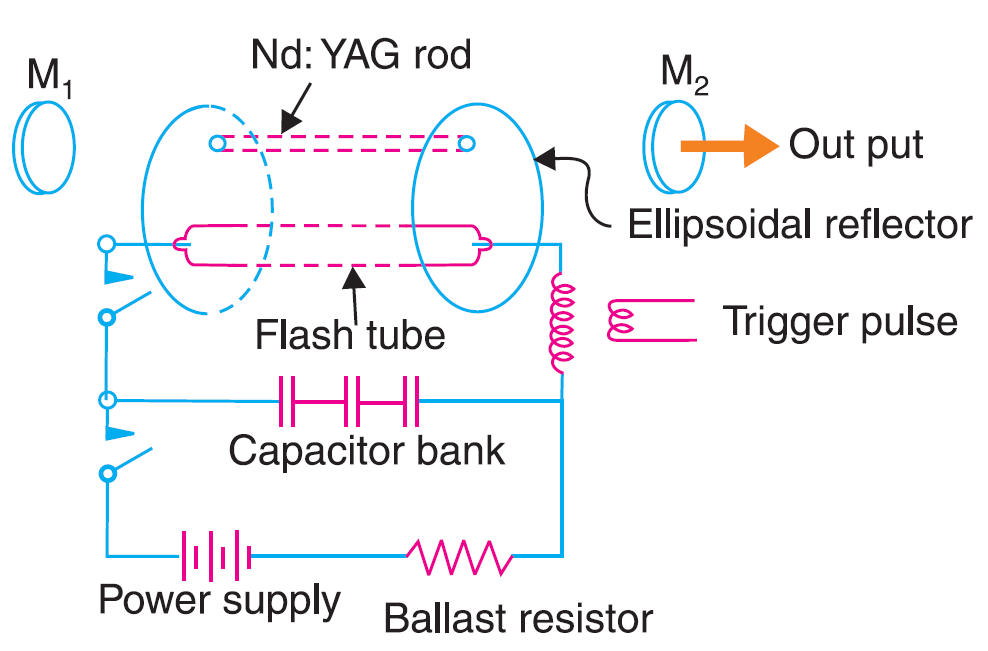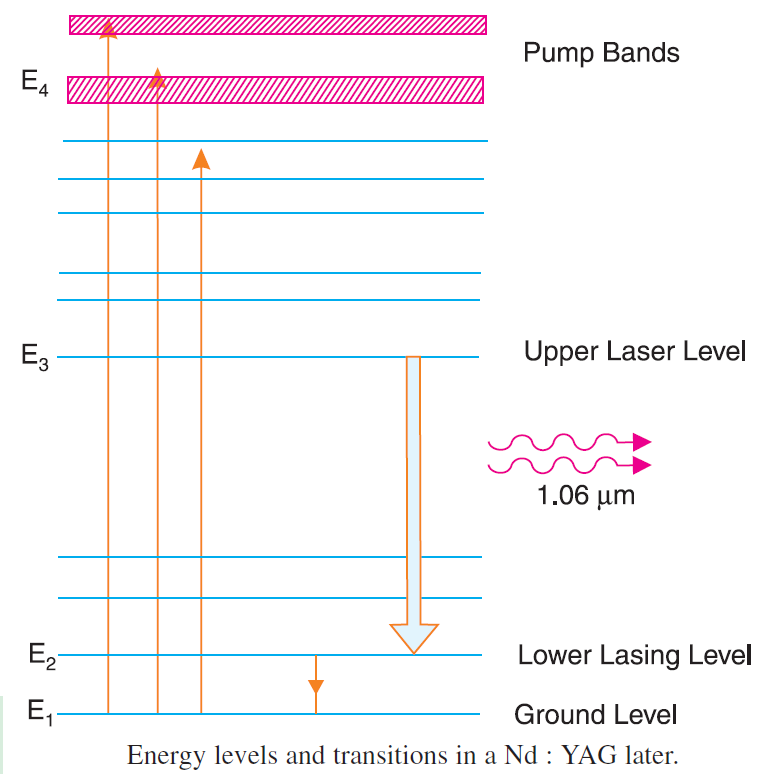The Nd:YAG laser (Neodymium-doped Yttrium Aluminum Garnet laser) is a solid-state laser that is widely used for industrial, medical, and military applications. It operates primarily in the infrared region with a wavelength of 1064 nm and is known for its high efficiency, stability, and power.
Nd:YAG lasers are optically pumped using flash lamps or laser diodes and are used in both continuous-wave (CW) and pulsed operations. They have diverse applications such as laser cutting, welding, medical treatments, and military targeting systems.
What is Nd:YAG Laser?
The Nd:YAG laser is a type of solid-state laser where the lasing medium is yttrium aluminum garnet (YAG) crystal doped with neodymium ions (Nd³⁺). The neodymium ions act as the active laser medium, providing the required energy levels for stimulated emission.
Key Features:
- Lasing Medium: Nd³⁺-doped YAG crystal
- Pump Source: Flash lamp or laser diode
- Wavelength: 1064 nm (infrared)
- Operation Modes: Continuous Wave (CW) & Pulsed
- Applications: Industrial, medical, military, and scientific research
Construction of a Nd:YAG Laser

The construction of an Nd:YAG laser consists of the following components:
Active Medium: The lasing material is a YAG crystal doped with Neodymium (Nd³⁺) ions. The YAG (Yttrium Aluminum Garnet) provides a strong host lattice for Nd³⁺ ions, ensuring high thermal conductivity and efficient lasing.
Optical Pumping Source: A flash lamp (xenon or krypton) or a laser diode is used to excite the neodymium ions to a higher energy level. The Flash lamps are common in high-energy pulsed lasers, while laser diodes offer efficiency and stability in CW lasers.
Optical Cavity (Resonator): It Consists of two mirrors (M₁ and M₂):
- M₁ (High Reflecting Mirror): Reflects almost all light.
- M₂ (Partially Reflecting Mirror): Allows some light to escape as the laser output.
These mirrors create a resonant cavity, where light amplification occurs through stimulated emission.
Ellipsoidal Reflector: Used to efficiently direct light from the flash lamp to the Nd:YAG rod, ensuring maximum absorption.
Power Supply & Trigger Circuit: A capacitor bank stores energy and supplies pulses to the flash tube for optical pumping. A trigger pulse helps in initiating the laser action.
Energy Level Diagram and Working of Nd:YAG Laser

The energy level diagram consists of four main energy levels:
- Ground Level (E₁): The lowest energy state where Nd³⁺ ions reside in an unexcited state.
- Lower Lasing Level (E₂): The state to which electrons fall after stimulated emission.
- Upper Laser Level (E₃): The metastable state where population inversion occurs.
- Pump Bands (E₄): The highest energy levels where Nd³⁺ ions are excited by optical pumping.
Step-by-Step Explanation of Laser Action
1. Optical Pumping (E₁ → E₄): External energy (from a flash lamp or diode) excites electrons from the ground state (E₁) to the higher energy levels (E₄). These levels are collectively known as the pump bands. The electrons do not stay at E₄ for long and quickly undergo non-radiative decay.
2. Non-Radiative Decay (E₄ → E₃): Electrons transition down to the upper laser level (E₃) without emitting radiation. This step is crucial because E₃ is a metastable state, meaning electrons stay here longer (creating population inversion).
3. Stimulated Emission (E₃ → E₂): When an electron in E₃ encounters a photon of 1064 nm (1.06 µm), it undergoes stimulated emission, releasing another photon of the same wavelength. This is the fundamental process of laser amplification.
4. Rapid Decay to Ground State (E₂ → E₁): The electrons in E₂ (lower lasing level) quickly drop to E₁ through non-radiative transitions. Since electrons do not stay in E₂, it prevents reabsorption of emitted photons, ensuring continuous laser action.
Key Features of the Nd:YAG Energy Level Diagram
- Four-Level System: Makes lasing more efficient than a three-level system.
- Metastable State (E₃): Allows accumulation of electrons, ensuring population inversion.
- Wavelength of Emission: 1064 nm (infrared region) is the primary laser output.
- Fast Decay from E₂ to E₁: Prevents loss of emitted photons, improving laser efficiency.
Mathematical Formulas of Nd:YAG Laser
Energy Transition and Wavelength
The wavelength of emitted laser light is determined by the energy difference between the upper laser level \( E_3 \) and the lower laser level \( E_2 \), given by:
\begin{equation}
E = h\nu = \frac{hc}{\lambda}
\end{equation}
where:
\( E \) is the energy of the emitted photon,
\( h \) is Planck’s constant (\( 6.626 \times 10^{-34} \) J·s),
\( \nu \) is the frequency of emitted radiation,
\( c \) is the speed of light (\( 3.0 \times 10^8 \) m/s),
\( \lambda \) is the wavelength of emitted laser light (for Nd:YAG, \( 1064 \) nm).
Population Inversion Condition
For laser action to occur, the population inversion condition must be satisfied:
\begin{equation}
N_3 > N_2
\end{equation}
where:
\( N_3 \) is the population of electrons in the upper laser level,
\( N_2 \) is the population of electrons in the lower laser level.
Rate Equations
The rate equations governing the population dynamics of the laser levels are:
\begin{equation}
\frac{dN_3}{dt} = R_p – \frac{N_3}{\tau_3} – W_{32}N_3
\end{equation}
\begin{equation}
\frac{dN_2}{dt} = W_{32}N_3 – \frac{N_2}{\tau_2}
\end{equation}
\begin{equation}
\frac{dN_1}{dt} = \frac{N_2}{\tau_2}
\end{equation}
where:
\( R_p \) is the pumping rate,
\( W_{32} \) is the spontaneous emission rate from level 3 to 2,
\( \tau_3 \) and \( \tau_2 \) are the lifetimes of levels 3 and 2, respectively.
Threshold Condition
The threshold population inversion for lasing is given by:
\begin{equation}
N_{th} = \frac{A_{21} + W_{21}}{\sigma \cdot g(\nu)}
\end{equation}
where:
\( A_{21} \) is the Einstein coefficient for spontaneous emission,
\( W_{21} \) is the transition probability,
\( \sigma \) is the stimulated emission cross-section,
\( g(\nu) \) is the line shape function.
Output Power
The laser output power is given by:
\begin{equation}
P = \eta \cdot h\nu \cdot (N_3 – N_2) \cdot V
\end{equation}
where:
\( \eta \) is the efficiency of the laser,
\( V \) is the active volume of the gain medium.
Advantages of Nd:YAG Laser
- High Power Output: Capable of generating high-energy laser pulses.
- Good Beam Quality: Produces a highly coherent, monochromatic beam.
- Efficient Optical Pumping: High absorption efficiency using flash lamps or diodes.
- Multiple Wavelengths: Can operate at different wavelengths (e.g., 1064 nm, 532 nm (frequency-doubled)).
- Long Lifespan: Nd:YAG rods have a long operational lifetime.
- Good Thermal Conductivity: Enables high-power operation with minimal heating issues.
- Versatile Applications: Used in medical, industrial, and military fields.
- Pulsed & CW Operation: Can operate in continuous and pulsed modes for different applications.
Disadvantages of Nd:YAG Laser
- High Initial Cost: Expensive compared to CO₂ and diode lasers.
- Low Efficiency: Optical pumping efficiency is relatively low.
- Complex Cooling System: Requires cooling to prevent thermal damage.
- Alignment Sensitivity: Requires precise optical alignment.
- Limited Wavelengths: Emits mainly at 1064 nm, limiting its use in applications needing different wavelengths.
Applications of Nd:YAG Laser
Industrial Applications:
- Laser Cutting & Welding: Used for precise cutting of metals, ceramics, and plastics.
- Drilling & Marking: Used for drilling small holes and engraving surfaces.
Medical Applications:
- Laser Surgery: Used in ophthalmology for retinal repairs (laser photocoagulation).
- Dermatology: Used for tattoo removal and skin resurfacing.
- Dental Procedures: Used in soft tissue surgeries.
Military & Defense:
- Laser Target Designation: Used in military targeting systems.
- Range Finding: Used for distance measurement in military applications.
Scientific Research:
- Spectroscopy: Used for high-resolution spectroscopic analysis.
- Nonlinear Optics: Used for frequency doubling (532 nm green laser).
Conclusion
The Nd:YAG laser is a powerful and versatile solid-state laser widely used in industrial, medical, and military fields. Its high power, efficiency, and excellent beam quality make it a preferred choice in applications requiring precision. However, its high cost and cooling requirements are some challenges. With advancements in laser diode pumping, Nd:YAG lasers continue to improve in efficiency and functionality, making them a key technology in modern laser systems.
